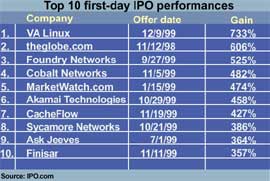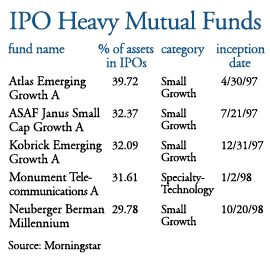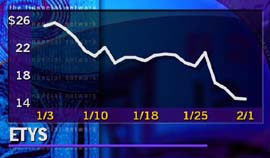|
IPO funds - for the brave
|
 |
February 2, 2000: 11:39 a.m. ET
IPO mutual funds can provide individual investors with a piece of the action
By Staff Writer Jennifer Karchmer
|
NEW YORK (CNNfn) - You're seething in envy watching technology IPOs go through the roof in their early days of trading. You wish you could get a piece of the action. But you're not so lucky -- or wealthy.
Large institutions and portfolio managers with clout can get in at the starting gate and scoop up shares at a low price. Individual investors usually can't get their hands on an initial public offering until it trades in the secondary market. By then, the price may have skyrocketed tenfold.
So IPO mutual funds may be the route to take if you've got the itch -- and the nerve.
Astronomical gains
IPOs had a record year in 1999 raising more than $69 billion, according to Thomson Financial Securities Data.

Contributing to those gains are names like Sycamore Networks (SCMR), a fiber-optics communications company, which more than tripled when it went public in the fall of 1999. The Web-based answering service AskJeeves.com (ASKJ) also provided a windfall for investors in early trading days.
Investing wisely
You're probably not going to see an IPO mutual fund offering in an employer-sponsored 401(k) plan because the pickings there tend to be limited and more conservative, according to financial advisor Christopher Conigliaro.
But if you want to dabble in IPOs and have something to talk about over the water cooler, you may choose to allocate a portion of your IRA or your taxable investing portfolio to an IPO mutual fund.
Conigliaro said younger investors might want to take an aggressive approach, setting aside up to 5 percent of their account. Many financial pros take a much more conservative approach and recommend a portfolio that is diversified across broad asset classes.
And if you're closer to retirement and are relying on your account for income, the IPO route may not be the best avenue because of the sector's high risk factor.
Instead of gritting your teeth at the eye-popping results, you can consider the following funds -- some of which invest up to one-third of their assets in IPOs.
The Oppenheimer Enterprise Fund (OENAX) earned 105.8 percent in 1999. That's quite a hike from 34.8 percent in 1998. But the fund is down 3.3 percent year to date as of Jan. 31.
According to a recent Morningstar report, the fund's success is due to a "boldness [which] has kept it at the fore of small-company offerings, but it could prove costly if the tech fire fizzles." Morningstar then goes on to warn, "the timid need not apply here."
In 1998, Renaissance Capital opened to retail investors the IPO Plus Aftermarket Fund (IPOSX), its first-ever mutual fund concentrating solely on IPOs. Top holdings include E Trade Group (EGRP), Equant (ENT) and Covad Communications Group (COVD). The fund earned 18.4 percent in 1998, 114.9 percent in 1999, and is up 0.8 percent year to date as of Jan. 31.
But while these funds' returns can be hefty, analysts agree they are extremely risky, likening their volatility to emerging markets.
"This is way out on the extreme edge of risk," says Morningstar analyst Russ Kinnel.

The bold and the brave
You should also keep in mind that not all IPOs are instant success stories. Etoys (ETYS), the Internet-based retailer for children's toys, which went public in 1999 at $76 a share, slid to $36 over the next few months and has traded substantially below its opening-day price.

Despite the tremendous gains that IPOs had in 1999, investors should know the good times in the market will not necessarily last.
"IPOs had such a phenomenal year last year, it's only logical to assume that going forward, performance will tail off," said Christine Benz, an associate editor at Morningstar.
Taking the plunge
If you're ready to dive into the IPO sector and invest in a mutual fund, here are some factors to keep in mind:
Size matters. Smaller funds, those under about $200 million, tend to perform better because big upswings of individual stocks will have a larger impact on fewer assets, according to Benz.
The Oppenheimer Enterprise Fund recently closed its doors to new investors because it was getting too large to manage. As of August 1999, the fund's assets were at $564 million.
Management. As with any mutual fund, target an experienced management team that has at least a five-year track record. That may be difficult to do since many of the IPO mutual funds were created in the last two or three years.
Diversify. As always, include a mixture of sectors in your retirement portfolio, including, small-, mid-, large-cap, and international funds. If your IPO mutual fund tanks, the rest of your diversified portfolio will cushion the blow.
Even if this year doesn't match up to last year's records, IPO funds may still be strong performers.
In the past few years, it's been all about the new dot.com companies. But Morningstar's Benz said investors are maturing. They want to see stronger balance sheets and good business models.
"Not every IPO will be the rocket ship that it was in 1999," she said. 
|
|
|
|
|
|
Morningstar
IPO.com
|
Note: Pages will open in a new browser window
External sites are not endorsed by CNNmoney
|
|
|
|
 |

|

